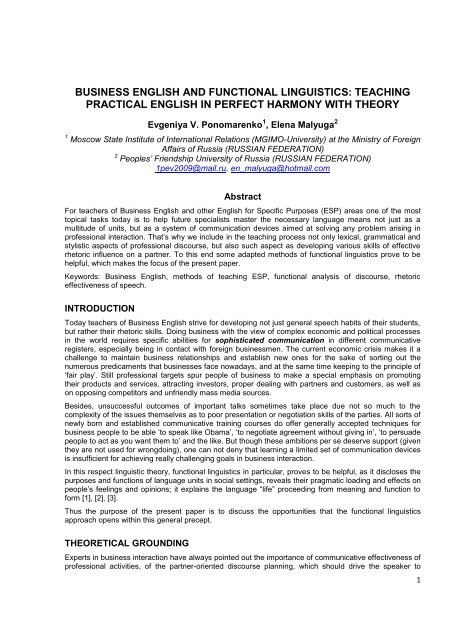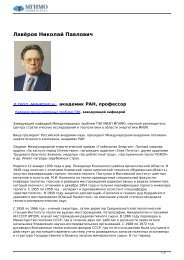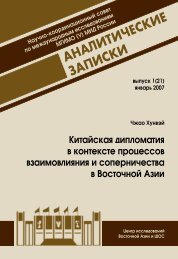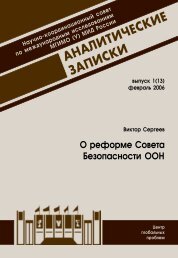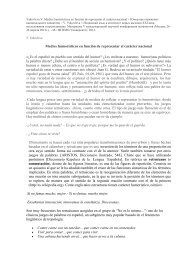BUSINESS ENGLISH AND FUNCTIONAL LINGUISTICS ...
BUSINESS ENGLISH AND FUNCTIONAL LINGUISTICS ...
BUSINESS ENGLISH AND FUNCTIONAL LINGUISTICS ...
Create successful ePaper yourself
Turn your PDF publications into a flip-book with our unique Google optimized e-Paper software.
<strong>BUSINESS</strong> <strong>ENGLISH</strong> <strong>AND</strong> <strong>FUNCTIONAL</strong> <strong>LINGUISTICS</strong>: TEACHING<br />
PRACTICAL <strong>ENGLISH</strong> IN PERFECT HARMONY WITH THEORY<br />
Evgeniya V. Ponomarenko 1 , Elena Malyuga 2<br />
1 Moscow State Institute of International Relations (MGIMO-University) at the Ministry of Foreign<br />
Affairs of Russia (RUSSIAN FEDERATION)<br />
2 Peoples’ Friendship University of Russia (RUSSIAN FEDERATION)<br />
1pev2009@mail.ru, en_malyuga@hotmail.com<br />
Abstract<br />
For teachers of Business English and other English for Specific Purposes (ESP) areas one of the most<br />
topical tasks today is to help future specialists master the necessary language means not just as a<br />
multitude of units, but as a system of communication devices aimed at solving any problem arising in<br />
professional interaction. That’s why we include in the teaching process not only lexical, grammatical and<br />
stylistic aspects of professional discourse, but also such aspect as developing various skills of effective<br />
rhetoric influence on a partner. To this end some adapted methods of functional linguistics prove to be<br />
helpful, which makes the focus of the present paper.<br />
Keywords: Business English, methods of teaching ESP, functional analysis of discourse, rhetoric<br />
effectiveness of speech.<br />
INTRODUCTION<br />
Today teachers of Business English strive for developing not just general speech habits of their students,<br />
but rather their rhetoric skills. Doing business with the view of complex economic and political processes<br />
in the world requires specific abilities for sophisticated communication in different communicative<br />
registers, especially being in contact with foreign businessmen. The current economic crisis makes it a<br />
challenge to maintain business relationships and establish new ones for the sake of sorting out the<br />
numerous predicaments that businesses face nowadays, and at the same time keeping to the principle of<br />
‘fair play’. Still professional targets spur people of business to make a special emphasis on promoting<br />
their products and services, attracting investors, proper dealing with partners and customers, as well as<br />
on opposing competitors and unfriendly mass media sources.<br />
Besides, unsuccessful outcomes of important talks sometimes take place due not so much to the<br />
complexity of the issues themselves as to poor presentation or negotiation skills of the parties. All sorts of<br />
newly born and established communicative training courses do offer generally accepted techniques for<br />
business people to be able ‘to speak like Obama’, ‘to negotiate agreement without giving in’, ‘to persuade<br />
people to act as you want them to’ and the like. But though these ambitions per se deserve support (given<br />
they are not used for wrongdoing), one can not deny that learning a limited set of communication devices<br />
is insufficient for achieving really challenging goals in business interaction.<br />
In this respect linguistic theory, functional linguistics in particular, proves to be helpful, as it discloses the<br />
purposes and functions of language units in social settings, reveals their pragmatic loading and effects on<br />
people’s feelings and opinions; it explains the language “life” proceeding from meaning and function to<br />
form [1], [2], [3].<br />
Thus the purpose of the present paper is to discuss the opportunities that the functional linguistics<br />
approach opens within this general precept.<br />
THEORETICAL GROUNDING<br />
Experts in business interaction have always pointed out the importance of communicative effectiveness of<br />
professional activities, of the partner-oriented discourse planning, which should drive the speaker to<br />
1
taking into close consideration the possible reactions on the part of the speech addressee. According to<br />
Michael McCaskey from Harvard School of Business, “as you examine misunderstandings between two<br />
managers, you will often find that what fouls the channels of communication is their mutual assumption<br />
that they are using the same words to mean the same things… What makes communication problematic<br />
is that people fail to recognize the personally distinctive ways in which others use words” [4]. In this<br />
respect a generalized judgment put forward by professor Olga Aleksandrova from Moscow State<br />
University accounts for the significance of functional analysis, as “it is impossible to denote the meaning<br />
of the communicative unit (a word, a word combination or a sentence) only with the help of a number of<br />
elementary components. But, according to the psycholinguistic investigations, a word does not possess<br />
any fixed meaning, there is always the multiform system of bonds” [5]. That is why we start teaching<br />
Business English with convincing students that in order to be efficient they have to assess the functional<br />
potential of the forms in which their thoughts and intentions are worded.<br />
Besides understanding the partner’s incentives and some individual properties, indispensible for<br />
successful communication is also the speaker’s competence in matters of intercultural interaction, as it is<br />
common knowledge that being persuasive in your own culture does not guarantee being persuasive in<br />
other cultures [6]. Therefore, the basics of functional linguistics make a good instrument that helps<br />
disclose what lies behind this or that way of formulating people’s positions in certain circumstances and<br />
within certain cultural contexts.<br />
Functional linguistics started being elaborated at the beginning of the XXth century within linguistic<br />
structuralism; but as by that time a vast amount of descriptive linguistic data had been accumulated, it<br />
became evident that time had come to search for more profound explanations of language structures<br />
activity. Thus, very soon the new tendency developed into a specific academic school focused mostly on<br />
how (and later, why) the described units function.<br />
It is assumed that the ground work for functionalism was done by Ferdinand de Saussure, Otto<br />
Jespersen, Jan Baudouin de Courtenay and others who posed a definite question of the interconnection<br />
between the semantic potential of language units within the language system and the actual meaning<br />
they acquire in speech under the influence of linguistic and non-linguistic factors of communication.<br />
Later such position grew into the ‘teleological’ principle substantiated by the Prague Linguistic Circle (the<br />
Prague School), according to which language should be analised as a teleological – purposeful – system<br />
of means of expression specially designed for communication. Among the founding members of the<br />
Prague School were such personalities as Vilém Mathesius (President of PLC until his death in 1945),<br />
Roman Jakobson, Nikolay Trubetzkoy, Sergei Karcevskiy, Jan Mukarovský, etc. The first results of the<br />
members’ cooperative efforts were presented in joint theses prepared for the First International Congress<br />
of Slavicists held in Prague in 1929. These were published in the first volume of the then started series<br />
Travaux du Cercle Linguistique de Prague. The Théses outlined the direction of the work of the Circle’s<br />
members. Such important concepts as the approach to the study of language as a synchronic system<br />
which is, however, dynamic, functionality of elements of language, and the importance of the social<br />
function of language were explicitly laid down as the basis for further research [7].<br />
Since then functional theories of language may be viewed as dominating in linguistic studies, as even<br />
more recent pragmatic and cognitive directions have, in fact, been elaborating the functional principles of<br />
language analysis and are closely related to them.<br />
The functional approach in linguistics has been substantially developed by S. Dik, T. van Dijk, R.P.<br />
Fawsett, M.A.K. Halliday, W.L. Chafe, G. Leech, J. Svartvik, O.V. Aleksandrova, G.A. Zolotova, V.A.<br />
Zvegintsev, E.S. Kubryakova, N.A. Slyusareva and many others whose works reveal the multisided<br />
functional interaction of various components of the multilayered, dynamic and flexible system of the<br />
natural human language. Various language units functions have been regarded in terms of their role as<br />
communication tools tailored for a twofold purpose: to perceive the world and to share the worldview with<br />
other people.<br />
In the wake of theoretical investigations, quite numerous applied functional concepts have appeared as<br />
an attempt to find better ways of teaching and learning foreign languages, especially stimulated by the allembracing<br />
globalization processes. The effectiveness of the functional approach to, for instance,<br />
improving students’ literacy has been proved and admitted, as can be seen from [8], [9], [10], [11] and<br />
other works.<br />
No less useful is functionalism for enhancing eloquence, as it develops a more profound and delicate<br />
linguistic feeling with students and helps them elaborate a more systemic and meaningful perception of<br />
speech – both their own and the communicating partner’s. Introducing elements of functional analysis into<br />
2
teaching methods, we show students the multisided semantic and pragmatic interconnection of definite<br />
linguistic elements comprising a discourse unit.<br />
METHODOLOGY<br />
The functional approach is pursued in teaching practically all aspects of English for Specific Purposes<br />
(even if it is not a teacher’s deliberate intention). From the very first lessons while training pronunciation<br />
we have to explain at least the main functional aspects of phonetics, such as:<br />
- semantic significance of sounds oppositions, like short vs long vowels (not to confuse, for<br />
instance, ‘butter’ and ‘barter’, ‘spot’ and ‘sport’, etc.), half open vs wide open vowels (‘set’ – ‘sat’,<br />
‘led’ – ‘lad’), voiced vs voiceless consonants, particularly in the final position (‘pence’ – ‘pens’,<br />
‘site/sight’ – ‘side’), etc.,<br />
- pragmatically relevant prosodic characteristics, like the inviting effect of the rising tone of closing<br />
phrases vs the dismissing and usually undesirable effect of the falling tone and so on.<br />
These features of English phonetics need special attention in Russian speaking audience as there are no<br />
similar phenomena in the Russian language, where vowels are short and final consonants mostly tend to<br />
be devoiced without causing trouble in making out the meaning. That’s why curious and sometimes<br />
ridiculous (or even offensive) semantic mistakes can be caused by a mere mispronunciation of only one<br />
sound – not a harmless incident during important business talks with foreign counterparts!<br />
Teaching English grammar is also impossible without resorting to functional analysis as, firstly, future<br />
specialists have to master the language structure which is essentially different from that of their native<br />
tongue. When they grasp the idea of functional loading of the units and models they study, it naturally<br />
facilitates the process of knowledge digestion. A typical example is the use of the Present Perfect Tense<br />
which Russian speaking students can disregard using instead Simple Past verb forms (better matching<br />
the Russian past tense structures) if they are unaware that the Present Perfect form has the inherent<br />
meaning of the existing result of the action completed.<br />
Secondly, we cannot ignore the communicative similarities and/or differences between grammar units<br />
and models. For example, in the process of internalizing the use of ‘shall’ in the meaning of obligation (so<br />
characteristic of the institutional discourse), students should acquire a clear-cut idea of the semantic and<br />
pragmatic properties this verb incorporates into a phrase as compared, say, to ‘will’ or ‘must’. So, we give<br />
a functional substantiation to pieces like:<br />
1) ‘The Agent shall provide an adequate organization for sales and, where appropriate, after-sales<br />
service, with all necessary means and personnel, in order to ensure the execution of his<br />
obligations throughout the Territory under this agreement’ – where ‘shall’ assigns the pragmatic<br />
meaning of obligation as inevitable duty;<br />
or<br />
2) ‘In carrying out their obligations under this agreement the parties will act in accordance with good<br />
faith and fair dealing’ – where ‘will’ suggests a voluntarily realized intention.<br />
In the lexicon study the functional approach is no less expedient. The book published by the English<br />
linguistics department of Moscow State University, Introduction to Functional Anglistics (1998) stated that<br />
“the functioning of words as such cannot be discussed without reservation, without taking into account<br />
additional information, the variety of specific connotations which cling to them” [12]. It is within this<br />
framework that students are taught to make the proper choice of a synonym or nomination variant<br />
considering the lexeme connotations, compliance with the author’s purport, the partner’s likely<br />
impression, and so on.<br />
Among various aspects of ESP from the functional perspective quite a labour-consuming one is<br />
discourse analysis when presumably all main linguistic devices used by the author are to be assessed<br />
as a unified and coherent system of interrelated means of pragmatic impact.<br />
For instance, at a lesson of English for Business Communication we discuss pieces like the Transcript of<br />
a Press Conference on the International Monetary Fund’s World Economic Outlook (Washington, April<br />
22, 2009), and state the following points.<br />
Asking about the economic situation in Russia and its neighbours, a journalist, referring to the IMF<br />
assertions that (Caucasian) Georgia had no economic downturn (despite its appeals for economic<br />
3
assistance), behaved, truly speaking, quite provocatively. His question was: “… how much of a problem is<br />
this for the IMF, the political pressure to cook the books? And does it increase in the crisis?” [13].<br />
One can hardly expect phrases like “political pressure” and “cook the books” to be amicably perceived by<br />
the IMF officials (notwithstanding the credibility or noncredibility of the statement itself). No wonder, the<br />
head of the World Economic Studies Division of the IMF gave a sharp answer:<br />
MR. DECRESSIN: Let me take the questions in turn. Let’s start with Russia. Russia is being hit by a<br />
trifecta of shocks. First, you’ve had the large decline in global trade. Second, you had the tightening of<br />
credit, the troubles in the banking system. Third, you had the drop in raw material prices and oil prices. So<br />
Russia, like the CIS as a whole, is experiencing the largest reversal of fortune, so to speak, among all the<br />
regions in the world [ibid].<br />
Leaving aside the actual economic problems in Russia, we have to point out that the linguistic<br />
characteristics of the given paragraph have acquired the following vivid peculiarities as compared to the<br />
previous speeches of the officials at the conference:<br />
the increased tempo of speech due to syntactic parallelism and shortening of sentence<br />
structures, and their stylistic colouring, which was not typical of the previous answers;<br />
the use of personal pronoun “you”, avoided in reference to representatives of other countries,<br />
because it makes the addressee feel his personal involvement in the critical state of things in his country,<br />
the inclusion of the nomination “trifecta of shocks”, which enhances depressive pragmatics and<br />
was never applied to any other country irrespective of the state of things (in some cases evidently worse<br />
than in Russia) in their economy.<br />
So, it is clear that reference to “the largest reversal of fortune among all the regions in the world” was<br />
made rather as a reciprocal rebuff to the journalist’s indelicate remark than as an objective estimate of the<br />
situation in Russia. And still we admit that such a way of presenting information forms a definitely<br />
negative and evidently biased opinion on the question discussed.<br />
All the above confirms that future participants in any area of the international arena have to acquire good<br />
knowledge of rhetoric devices and understanding of language functional potential. It is only natural that<br />
for teachers of foreign languages developing their students’ communicative competence is of critical<br />
importance. But this competence is not confined to an extensive individual vocabulary, discourse clichés<br />
and fluency in speech. No less vital is the rhetoric effectiveness of speech. Otherwise, as we see, even<br />
quite knowledgeable professionals may fail in accomplishing their goals – like the above journalist who,<br />
instead of sorting out the information he was after, received negative feedback.<br />
Back in 1937 Dale Carnegie in his famous book How to Win Friends and Influence People cited J.D.<br />
Rockefeller who considered the ability to deal with people “as purchasable a commodity as sugar or<br />
coffee” and was ready to “pay more for that ability than for any other under the sun” [14]. No doubt, he was<br />
not so naïve as to throw money away.<br />
That is why the ESP programmes at the leading Russian universities which educate specialists for<br />
international activities (namely, Moscow State Institute of International Relations (MGIMO-University) at<br />
the Ministry of Foreign Affairs of Russia and the People’s Friendship University of Russia) comprise quite a<br />
number of relevant aspects.<br />
Thus, we introduce elements of functional analysis working, for instance, at the well-known Market Leader<br />
course (which is one of the best ever created Business English courses) containing very good examples of<br />
cross-cultural business interaction, such as the video resource named Alliance [15]. The story has its<br />
setting ‘between two continents’, figuratively speaking, as it is about a planned merger of two airline<br />
companies – the American TransWest Airlines and the Hong Kong-based Air Pacifica. Being well aware of<br />
the natural complications on this road, the management of the companies hire an American consultancy<br />
specializing in this kind of deals.<br />
It is remarkable how, from the very first steps, already in her opening presentation, the representative of<br />
the consulting group Anna Valdez wins the audience with her high professionalism and, above all,<br />
outstanding communication skills. After a warm welcome she starts outlining the possible difficulties of<br />
going global for both companies, gradually intensifying the impression of the inevitable hardships of the<br />
task and the necessity for the partners to be open to a whole lot of innovations, not always easy-going.<br />
Such phrases as high risk, brutal facts, failure, only one third has a future, falls apart, differences in culture,<br />
differences in management styles and others of the like are surely aimed at preparing the listeners for the<br />
coming commitments.<br />
4
But in order not to produce a totally distressing effect, the lady at the same time resorts to the positive<br />
thinking attitude (peculiar to Americans, as is known). The rhetoric of unity and shared interests is often<br />
supported by the personal pronoun we; here and there Anna drops in references to long-term success, the<br />
success we all want it to be, avoid making the same mistakes, the right balance, managing diversity, and<br />
finishes her speech with a promise of an exceptionally successful alliance in case the partners accept a<br />
willingness to change, which met a unanimous approval of the audience.<br />
This presentation usually makes a gripping first impression on our students. But then we have to draw their<br />
attention to the way it is structured, worded and delivered – these are the facets comprising the general<br />
effect. It is evident that in terms of functional loading such samples of Business English discourse make a<br />
worthwhile object of analysis from the angle of not only their lexical and syntactic structures, but also of<br />
their rhetoric and stylistic properties. Students should be well aware of quite a number of aspects, such as:<br />
- the basic communication strategy (that of cooperation),<br />
- the supplementary discourse strategies (those of self-presentation, control of the topic, semantic<br />
foregrounding, intensifying or reduction of pragmatic strain, etc.),<br />
- the communication tactics implementing the above strategies (generalization, attracting or<br />
diverting attention, mitigation, exemplifying, reiteration, etc.),<br />
- the rhetoric figures of speech and stylistic devices implementing the above tactics (rhetorical<br />
questions, metaphors, hyperboles, inversions, irony, lexical and syntactic parallelism, etc.)<br />
For Business students not to be embarrassed with difficult linguistic terms it is recommended to change<br />
them for more recognizable or non-terminology equivalents: ‘redundancy’ seems preferable to ‘pleonasm’,<br />
‘junction’ – to ‘anadiplosis’, and so on.<br />
In the further parts of the video course there are many more episodes analyzing which we disclose the<br />
functional loading of particular lexical and structural units, stylistic devices, the systemic character of their<br />
combination aimed at actualizing the proper semantic and pragmatic meanings.<br />
Special attention is paid to the inappropriate use of linguistic means leading to communicative abuse.<br />
Here, besides one’s personal features, counts another critical factor of communication between people of<br />
different origin – intercultural differences. Thus, for instance, in the story of the said alliance we see clear<br />
distinctions between the debating manners of the American negotiator (open, determined, self-assured,<br />
sometimes pushy) and his Chinese counterpart (composed, polite, sometimes indirect but resolute). At the<br />
early stage of their talks not everything went smooth. Students always take pleasure in playing the<br />
proposed episodes as participants in the depicted events, but feeling already quite sophisticated<br />
communicators, they make the necessary changes in the characters’ parts leading them to a more<br />
successful outcome.<br />
Consideration for national mentality is indispensable for mutual understanding between peoples. So future<br />
businessmen and politicians who plan to work on the international scene should spare no effort trying to<br />
learn as much as possible about their would-be partners’ national customs and traditions, bearing in mind<br />
the peculiar functional significance of language units, ethnically specific communication models and the<br />
possible aftereffects of their inappropriate usage.<br />
CONCLUSION<br />
Polishing the ability to provide a sophisticated combination of different level linguistic means, their coherent<br />
interaction and, most importantly, competent use of functional analysis, on the one hand, definitely<br />
elaborate students’ skills in building up efficient discourse and presenting any professional matter in a most<br />
advantageous view. On the other hand, these qualities form sort of mental ‘defence’ against a possible<br />
negative influence on their minds in case of an outward attempt of psychological manipulation. Functional<br />
analysis of texts exemplifying both efficient and inefficient business communication enhances alongside<br />
students’ communicative skills their general professionally relevant competences. For future businessmen,<br />
lawyers, politicians, diplomats and other specialists who plan to participate in international affairs the<br />
functional approach to business English is highly recommendable.<br />
REFERENCES<br />
5
[1] Fawsett, R.P. (2008). Invitation to Systemic Functional Linguistics through the Cardiff Grammar. An<br />
Extension and Simplification of Halliday’s Systemic Functional Grammar (Third Edition). Sheffield,<br />
Equinox Publishing Ltd.<br />
[2] Halliday, M.A.K. (1985). An Introduction to Functional Grammar. London, Edward Arnold.<br />
[3] Halliday, M.A.K. (2002). Linguistic Studies of Text and Discourse. Volume 2 in the Collected Works of<br />
M.A.K. Halliday. Edited by J. J. Webster. London, New York, etc., Bloomsbury Publishing, Continuum.<br />
[4] McCaskey M. B. (1999). The Hidden Messages Managers Send. In Harvard Business Review on<br />
Effective Communication. Boston, MA, Harvard Business School Publishing, pp. 119-143.<br />
[5] Aleksandrova, O. (2011). Lexicogrammatical Foundation of the Language. In LATEUM 2011.<br />
Linguistics and ELT Today: Traditions and Innovation. Proceedings of the 10 th International Conference.<br />
Edited by O.V. Aleksandrova. Moscow, MAKS Press, pp. 7-11.<br />
[6] Thomas, D.C. (2008). Cross-cultural management: Essential concepts. Thousand Oaks, CA, Sage.<br />
[7] Prague Linguistics. [Electronic resource]. Mode of access: http://www.praguelinguistics.org/en/about<br />
[8] Castel, V. M. (2007). Rule Types in a Systemic Functional Grammar: An XML Definition of the Cardiff<br />
Lexicogrammar Generator. In Barbara, Leila and Tony Berber Sardinha (eds.) Proceedings of the 33rd<br />
International Systemic Functional Congress, PUCSP, São Paulo, Brazil, pp. 270-299.<br />
[9] Martin, J.R. (1997). Linguistics and the Consumer: The Practice of Theory. In Linguistics and<br />
Education, vol. 9, issue 4, pp. 411-448.<br />
[10] Schleppegrell, M. J. (2012). Systemic Functional Linguistics: Exploring meaning in language. In<br />
James Paul Gee and Michael Handford (Eds.), The Routledge Handbook of Discourse Analysis, pp. 21-<br />
34. New York, Routledge.<br />
[11] Whittaker R., McCabe A., O’Donnell M. (2006) Language and Literacy: Functional Approaches.<br />
London, New York, etc.: Bloomsbury Publishing, Continuum.<br />
[12] Introduction to Functional Anglistics (1998). Edited by O.V. Aleksandrova. Moscow, Lomonosov<br />
Moscow State University, p. 102.<br />
[13] Transcript of a Press Conference on the International Monetary Fund’s World Economic Outlook<br />
(2009). In The International Monetary Fund. [Electronic resource]. Mode of access:<br />
http://www.imf.org/external/np/tr/2009/tr042209.htm .<br />
[14] Carnegie, D. (2005). How to Win Friends and Influence People. St.Petersbourg, КАРО, p.9.<br />
[15] Crowe, R., Pickford, P. (2000). Market Leader. Alliance. Video Resource Book. Business English.<br />
Harlow, Essex, Pearson Education Ltd.<br />
6


